Injuries, just like in any sport, are inevitable. However, the risk of getting injured is higher in gymnastics, where leaps, flips, and twists are part of the routine. I've been training hundreds of gymnasts for years now, but I can't help but feel a deep sense of responsibility for their safety and well-being. Every time a gymnast steps onto the mat or approaches an apparatus, I am acutely aware of their potential risks.
Despite my experience and expertise, I know that accidents can happen instantly, so I'm constantly striving to enhance safety measures and instil proper techniques in my athletes. It's a constant balancing act between pushing them to reach their full potential and ensuring they stay injury-free. As a trainer, my greatest satisfaction comes from seeing my gymnasts progress and succeed, knowing that I've played a role in keeping them safe.
Throughout my years of coaching, I've learned that prevention is key. It's not just about perfecting those routines; it's also about understanding your body and its limits.
In this blog, we'll delve into the common injuries gymnasts face, how they occur, and, most importantly, how to prevent them. So, whether you're a budding gymnast or a seasoned pro, let's flip into action and learn to stay safe while soaring through the air!
Injuries are an unfortunate reality in the world of gymnastics. From sprained ankles to more serious fractures, gymnasts can face a variety of injuries during their training and competitions. But just how common are these injuries?
Injuries occur but are not as rampant as some may fear. When proper training techniques and safety measures are in place, the risk of injury can be significantly reduced.
Based on statistics discussed by Gitnux:
While gymnasts are known for their strength, flexibility, and agility, the nature of the sport also exposes them to certain risks. Let's take a closer look at some of the most common injuries faced by gymnasts:
The most prevalent injury in gymnastics is sprained ankles, which occur when a gymnast lands awkwardly or twists their ankle during a routine. This can happen on any apparatus but is particularly common on the floor exercise and vault.
Gymnasts put significant weight on their wrists, especially during skills like handstands and tumbling passes. As a result, wrist sprains and strains are common, along with overuse injuries like tendonitis.
The knees endure much stress in gymnastics, particularly during landings and jumps. Common knee injuries include ligament sprains, meniscus tears, and patellar tendonitis.
The repetitive nature of gymnastics movements, combined with the need for extreme flexibility, can strain the lower back. Gymnasts are susceptible to conditions like spondylolysis (stress fractures in the vertebrae) and muscle strains.
While less common, fractures can occur in gymnastics, especially in high-impact events like the vault or floor exercise. Fractures can affect various bones, including the wrists, ankles, and spine.
Here are some common causes we observed during training that would often cause injuries among our athletes:
Throughout the history of gymnastics, several notable injuries have captured the attention of fans and athletes alike. While these incidents are often unfortunate, they remind us of the risks inherent in the sport and the resilience of gymnasts in overcoming adversity. Here are a few famous gymnastics injuries that have left a lasting impact:
Perhaps one of the most iconic moments in gymnastics history, Kerri Strug's vault during the team competition at the 1996 Atlanta Olympics is etched into the memory of sports fans worldwide. Despite injuring her ankle during her first vault attempt, Strug courageously performed a second vault, securing the gold medal for Team USA. Her determination in the face of injury symbolised perseverance and dedication.
In 1979, Soviet gymnast Elena Mukhina suffered a devastating injury while practising a dangerous tumbling pass on the floor exercise. The accident left her paralysed from the waist down, ending her gymnastics career and casting a sad light on the risks involved in the pursuit of perfection.
British gymnast Beth Tweddle experienced a serious injury during rehearsals for the reality TV show "The Jump" in 2016. She fractured two vertebrae in her neck while performing a ski jump, leading to emergency surgery. Tweddle's injury highlighted the importance of proper safety measures, even in non-competitive settings.
During the vault final at the 2021 World Championships, Simone Biles experienced a rare error, landing awkwardly and stumbling off the mat. While she avoided serious injury, the incident served as a reminder that even the most skilled gymnasts are not immune to mistakes and the potential consequences.
During a competition in 1980, Romanian gymnast Nadia Comăneci, renowned for her perfection in gymnastics, suffered a rare fall from the balance beam. The fall shocked fans and competitors alike, serving as a reminder that even the most accomplished athletes can experience setbacks.
In 1976, Soviet gymnast Olga Korbut, known for her innovative and daring routines, experienced a fall during her uneven bars routine at the Montreal Olympics. The fall cost her a chance at winning a medal in the event, underscoring the fine line between success and disappointment in gymnastics.
NBC News ranks gymnastics among riskiest sports.
That is why ensuring the safety and well-being of our athletes is our primary priority as gymnastics trainers. Although injuries are an unpleasant part of the sport, we can use several strategies to reduce the danger and maintain the health and well-being of our gymnasts.
We ensure that gymnasts perform a complete warm-up routine before each training session and competition. Improving muscle blood flow helps them become more pliable and less prone to damage. Dynamic stretches and exercises tailored to gymnastics techniques can help the body get ready for the demands of training.
Emphasising proper technique and form is essential in gymnastics. Ensuring that gymnasts master the fundamentals of each skill before progressing to more advanced movements can help reduce the risk of injury. Regular feedback and corrections during training sessions can help reinforce good habits and prevent harmful habits from developing.
Progressing too quickly to advanced skills without adequate preparation can increase the risk of injury. Implementing a structured training plan that gradually builds upon foundational skills allows gymnasts to safely develop strength, coordination, and confidence. Additionally, incorporating rest days and active recovery periods into training schedules can help prevent overuse injuries.
Regularly inspecting and maintaining gymnastics equipment, such as mats, bars, and beams, is essential for ensuring a safe training environment. Checking for signs of wear and tear, securing equipment properly, and providing sufficient padding can help minimise the risk of accidents and injuries during practice sessions.
Having qualified coaches and spotters present during training sessions is crucial for providing guidance, support, and assistance when needed. Coaches can help identify potential hazards, correct technique errors, and intervene to prevent accidents before they occur. Additionally, teaching gymnasts how to fall safely and spot each other during skills can empower them to take ownership of their safety.
Incorporating cross-training activities and strength conditioning exercises into gymnasts' training regimens can help improve overall fitness, stability, and resilience. Building strength in key muscle groups, such as the core, shoulders, and legs, can enhance performance and reduce the risk of injury during high-impact skills.
Gymnastics injuries can vary in severity, ranging from minor strains and sprains to more serious fractures or dislocations, depending on the nature of the activity and the athlete's experience level.
If a gymnast sustains an injury, they must prioritize their health and well-being by seeking immediate medical attention. As their trainer,we strictly advise them to follow the guidance of their healthcare provider carefully and to communicate openly about their injury status and recovery progress.
Beginners in gymnastics may face a higher risk of injury compared to experienced gymnasts due to their unfamiliarity with proper technique and conditioning. However, with proper coaching, progression, and adherence to safety guidelines, beginners can minimize their risk of injury over time.
Overtraining is a common concern in gymnastics and can indeed contribute to injuries. I emphasize balancing training intensity with adequate rest and recovery as a trainer. By incorporating cross-training activities, monitoring workload, and promoting proper recovery strategies, I aim to help gymnasts prevent overuse injuries and maintain peak performance safely.
While gymnastics is demanding and potentially risky, injuries can be minimized with the right precautions and approach. As gymnastics trainers, coaches, parents, and athletes, it's crucial to prioritize safety above all else.
Focusing on proper technique, gradual progression, adequate conditioning, and maintaining equipment can create a safer environment for gymnasts to thrive in. Remember, injury prevention is a team effort, and by working together, we can ensure that gymnasts can pursue their passion for the sport safely and confidently. Stay focused and diligent, and prioritize your well-being above all else.
Strength training isn't just about pumping iron or getting swole (although that's a cool bonus). It's about giving your body the power to perform at its peak. Think of it like fuelling up a race car—you wouldn't expect it to win without a powerful engine under the bonnet.
In gymnastics, strength is the engine that drives everything else. It helps you leap higher, swing faster, and confidently stick to those landings. Plus, it's like a safety net, reducing your risk of injury by supporting your joints and stabilising your movements.
As a gymnastics trainer with years of experience, I've witnessed firsthand the importance of core strength for gymnasts. It's about having a six-pack and building a solid foundation for every move.
I often see gymnasts need help to maintain proper form during handstands or to execute clean tucks and layouts. More often than not, it comes down to needing more core stability. That's why I always emphasise core-focused exercises in our training sessions.
One of my favourite drills is the hollow hold. It's a simple yet effective exercise that teaches gymnasts to engage their core muscles while maintaining a straight body position—a skill essential for mastering various gymnastics elements. I've seen remarkable improvements in my students' overall performance after incorporating hollow holds into their routines.
When it comes to upper body strength, I've found that many gymnasts underestimate its importance. But as any seasoned gymnast will tell you, strong arms and shoulders are essential for executing those picture-perfect handstands and powerful swings on the bars.
I remember working with a young gymnast who struggled with her handstand on the balance beam. No matter how hard she tried, she couldn't hold the position for more than a few seconds. After implementing a structured upper body strength training routine—including exercises like press-ups and pull-ups—her handstand improved dramatically within just a few weeks.
Leg strength is often overlooked in gymnastics, but it's vital for generating power and stability during jumps, leaps, and landings. As a trainer, I include plenty of leg-focused exercises in our workouts to help gymnasts develop the strength and endurance needed to excel in their routines.
In the fast-paced world of gymnastics, flexibility and mobility often take a backseat to strength training. However, as a trainer, I know firsthand how crucial they are for preventing injuries and maximising performance.
I've seen countless gymnasts sidelined by injuries simply because they neglected their flexibility and mobility. I always emphasise incorporating stretching and mobility exercises into our training sessions.
Determining the right age to start incorporating strength training into a gymnast's routine is a question I get asked often as a trainer. While there's no one-size-fits-all answer, some important factors must be considered.
Generally, I recommend introducing basic strength exercises to gymnasts around the age of 7 or 8, provided they have a solid foundation in gymnastics fundamentals and proper technique. At this age, children are typically more coordinated and able to follow instructions, making it a suitable time to begin building strength in a safe and controlled manner.
However, it's important to approach strength training with caution and tailor it to each gymnast's individual needs and abilities. Younger gymnasts should focus on bodyweight exercises, balance, and coordination drills rather than heavy weights or intense resistance training to avoid placing undue stress on developing muscles and joints.
As gymnasts progress in age and skill level, their strength training routines can gradually become more advanced, incorporating resistance bands, light weights, and additional exercises to target specific muscle groups relevant to their discipline.
Ultimately, the key is prioritising proper form, safety, and gradual progression when introducing strength training to gymnasts of any age. Consulting with a qualified gymnastics coach or trainer can help ensure that strength training is integrated effectively and safely into a gymnast's overall training regimen.
You don't need fancy equipment or a high-tech gym to get results when it comes to gymnastics strength training. Some of the most effective exercises can be done using simple equipment you can access. Here are a few key pieces of equipment commonly used in gymnastics strength training:
Gymnastics rings are versatile tools that can be used to target upper body and core strength, as well as balance and stability. Ring exercises like ring dips, ring rows, and ring press-ups require immense strength and coordination, making them ideal for gymnasts to level up their skills.
A pull-up bar is a staple in any gymnastics gym. It's perfect for building upper body strength and mastering skills like pull-ups, chin-ups, and leg raises. Plus, it's portable and easily installed in most doorframes, making it accessible for home workouts.
Foam mats provide a supportive surface for gymnasts to practice exercises and drills safely. Whether you're working on handstands, cartwheels, or tumbling passes, foam mats help cushion impact and reduce the risk of injury, making them an essential piece of equipment in any gymnastics training environment.
Resistance bands are invaluable tools for building strength, flexibility, and mobility. They can be used to add resistance to bodyweight exercises like squats, lunges, and glute bridges and assist with stretching and mobility exercises. Plus, they're lightweight and portable, making them perfect for on-the-go training sessions.
Stability balls are excellent for targeting core strength and stability. Exercises like ball pikes, ball rollouts, and plank variations challenge your balance and engage your core muscles in a way that traditional floor exercises can't. Plus, they add an element of fun and variety to your strength training routine.
Parallettes are small, portable bars perfect for practising gymnastics skills like dips, L-sits, and handstand press-ups. They provide a stable surface for performing these exercises while also helping to improve wrist mobility and strengthen the shoulders and core.
Bosu balls are half-dome stability trainers that can add an extra challenge to your strength training routine. Exercises like squats, lunges, and press-ups performed on a Bosu ball require increased stability and balance, making them great for targeting stabilising muscles and improving overall athleticism.
In addition to strength training, flexibility is essential for gymnasts to perform at their best and prevent injuries. Foam rollers and stretch straps are great tools for improving flexibility and mobility by releasing muscle tension and increasing range of motion.
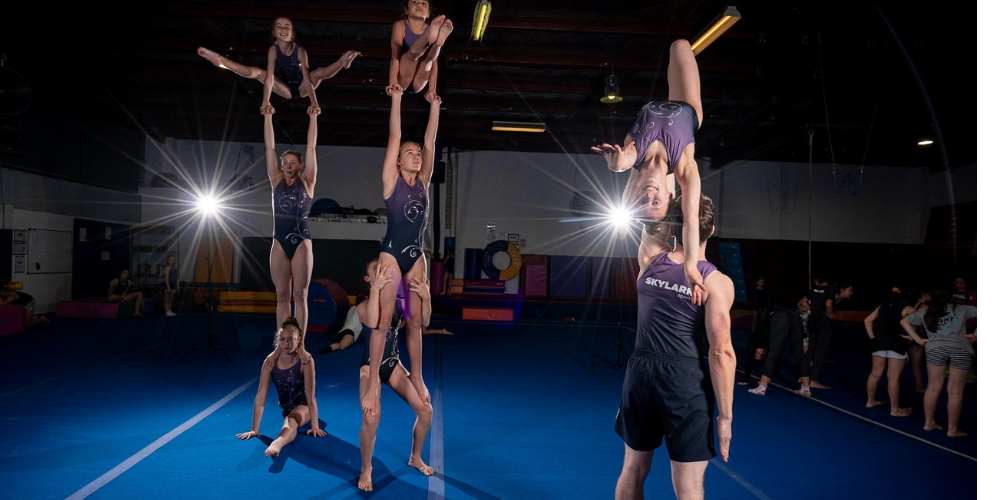
Strength training is the backbone of success in gymnastics, and its importance cannot be overstated. As a gymnastics trainer, I've seen firsthand how strength forms the foundation upon which all other skills are built. Here's why strength training is crucial in the world of gymnastics:
Gymnastics is all about explosive movements—vaulting off the springboard, launching into flips and twists, and sticking landings precisely. Developing strength allows gymnasts to generate the power to execute these moves quickly and gracefully.
Strong muscles act as protective armour for the body, reducing the risk of injury during the high-impact manoeuvres performed in gymnastics. A well-rounded strength training programme helps to strengthen muscles, tendons, and ligaments, providing stability and support to vulnerable areas like the knees, ankles, and wrists.
Strength training directly translates to improved performance in gymnastics. Stronger muscles enable gymnasts to execute skills with greater control, precision, and confidence. Whether mastering a new skill on the balance beam or perfecting a routine on the uneven bars, increased strength empowers gymnasts to push their limits and achieve new heights of excellence.
The core is the body's powerhouse in gymnastics, providing stability and control for virtually every movement. A strong core is essential for maintaining proper form during handstands, backflips, and twists. Strength training exercises that target the core—such as planks, hollow holds, and leg lifts—help gymnasts develop the strength and stability needed to execute these moves with finesse.
Strength training isn't just about building physical strength; it cultivates mental toughness and resilience. Pushing through challenging workouts, overcoming setbacks, and achieving personal bests in the gym instil confidence and determination that carry over into every aspect of a gymnast's life, both inside and outside the gym.
The strength required in gymnastics is as diverse and demanding as the sport. Gymnasts require various types of strength, including upper body, core, and lower body strength, to perform their incredible feats.
Gymnasts rely heavily on their upper body strength to perform various skills on the bars, rings, and parallel bars. This includes muscles in the arms, shoulders, chest, and back. Upper body strength is crucial for controlling and precision executing moves like handstands, swings, and dynamic releases.
The gymnastics powerhouse's core provides stability and control for nearly every movement. A strong core is essential for maintaining proper form during handstands, backflips, and twists. Core strength helps gymnasts maintain balance, control their body position, and generate power for explosive movements.
Strong legs are essential for power and stability during jumps, leaps, and landings. Muscles in the legs, including the quadriceps, hamstrings, calves, and glutes, play a crucial role in executing skills on the floor, vault, and balance beam. Lower body strength helps gymnasts achieve height and distance in their jumps and landings with precision.
Gymnasts rely on their grip strength to maintain control and stability while performing on apparatus like bars and rings. Strong hands and forearms are essential for gripping the apparatus securely and executing complex swinging and release moves without slipping or losing control.
While not strictly strength-related, flexibility and mobility are integral to gymnastics performance. Flexible muscles and joints allow gymnasts to achieve a full range of motion in their movements, while good mobility ensures fluidity and grace in transitions between skills. Flexibility and mobility also play a role in injury prevention by reducing muscle tension and improving joint stability.
Absolutely. Strength training plays a crucial role in injury prevention for gymnasts. By strengthening muscles, tendons, and ligaments, gymnasts can improve joint stability and reduce the risk of common injuries associated with the sport, such as sprains, strains, and stress fractures. Additionally, strength training helps correct muscular imbalances and enhances overall body awareness, leading to safer and more controlled movement during training and competition.
The frequency of strength training sessions for gymnasts depends on several factors, including age, skill level, and training goals. As a general guideline, gymnasts should incorporate strength training into their weekly regimen at least 2-3 times per week. These sessions should be balanced with rest and recovery to allow muscles to adapt and grow stronger. It's important to vary the intensity and focus of each session to target different muscle groups and prevent overtraining.
We measure progress in gymnastics, which can be measured by improved skills and routines, increased exercise resistance, changes in body composition, and tracking personal records for specific exercises.
Incorporating strength training into your gymnastics routine is a game-changer. Not only does it enhance your performance and reduce the risk of injuries, but it also lays the groundwork for mastering those awe-inspiring skills you've been dreaming of.
Remember to prioritise proper form, stay consistent with your training, and listen to your body's needs. Whether you're a seasoned competitor or just starting, don't underestimate the power of strength—it's the key to unlocking your full potential as a gymnast. So grab those grips, hit the mat, and get stronger together!
Reading time: 6min 43 sec
When parents visit our gym in Melbourne, they often ask, "Is gymnastics the same as dancing? And which one is better for my child?" It's a great question and one that many parents ponder.
As a gymnastics trainer with years of experience, I've seen both worlds up close. While gymnastics move and dance share some similarities, they're also quite different in their ways.
In this blog, we'll explore the unique benefits of gymnastics and dance for kids, helping you decide which path might best fit your child's interests and development. So, let's dive in and uncover the wonders of both disciplines!
Yes, you read it right! At an early age, you should encourage your child to stay active, whether it's through gymnastics, dance, or any other physical activity they enjoy.
According to the Centers for Disease Control and Prevention, " The Physical Activity Guidelines for Americans, 2nd edition recommends that children and adolescents ages 6 to 17 years do 60 minutes or more of moderate-to-vigorous physical activity daily."
Moreover, frequent exercise can help kids and teenagers get fit aerobically and respiratory, grow strong bones and muscles, manage their weight, lessen the symptoms of anxiety and sadness, and lower their chance of contracting diseases like:
Engaging in physical activities such as dancing or gymnastics gives kids a constructive way to release their pent-up energy and feelings. It elevates mood, lessens tension and anxiety, and increases self-worth. Frequent physical activity provides a much-needed chance for children to detach, relax, and recharge in today's fast-paced environment, where they are frequently overburdened with academic obligations and digital distractions.
The main goals of gymnastics are to become proficient in flips, jumps, and balance routines on bars and beams. It's similar to an enjoyable workout that improves coordination, strength, and flexibility—all necessary for an active, healthy lifestyle.
While with dancing, kids can express themselves via diverse forms like ballet, hip-hop, or jazz while also learning how to move their bodies in new ways through the rhythmic adventure of dancing. It's a great way to have fun and improve musicianship and agility.
Gymnastics routines are like puzzle pieces that need to fit just right. There's a set routine to follow, which helps kids develop discipline and focus as they work towards mastering each move.
Meanwhile, dancing is a canvas for creativity. There are no strict rules to follow—just a stage to unleash your child's imagination and let them dance to their heart's content. It's an excellent outlet for self-expression and building confidence.
Young athletes compete in gymnastics contests, exciting occasions where they display their skills. They aim to please the judges with a flawless routine or perfect landing.
Kids who dance frequently go on to give stunning performances in recitals or shows, where they may shine in front of an audience and share their enthusiasm with friends and family.
There are risks associated with dancing and gymnastics. Still, these activities may also be thrilling and safe under the right guidance and supervision. In gymnastics, it's important to ensure the apparatus is in good condition and the coaches are on guard. When it comes to dancing, it's about teaching youngsters the right methods to avoid getting hurt when they're busting a move.
Determining whether dancing or gymnastics is harder is like comparing apples to oranges—both are challenging in their unique ways.
Gymnastics demands a high degree of strength, resilience, and physical strength. It involves mastering challenging techniques like flips, twists, and balancing feats, frequently done on equipment like vaults, bars, and beams. Gymnasts put in a lot of practice to master their routines, and there is often very little room for error. There's also the extra strain of competing, where athletes must perform perfectly in front of judges.
Dancing, on the other hand, demands a different set of skills. While it may not require the same level of physical strength as gymnastics, it does require excellent coordination, rhythm, and body control. Dancers must memorize complex choreography, execute precise movements, and convey emotion through performance. Each dance style presents challenges, whether mastering ballet's elegance, hip-hop's athleticism, or contemporary dance's gracefulness.
In terms of physical demands, both activities can be equally demanding, but they require different types of athleticism. Gymnastics may require more explosive power and strength while dancing emphasizes endurance, flexibility, and artistry.
But for me, the best answer is
Choosing between gymnastics and dancing for your kids can be a tough decision, but there are a few key factors to consider to help you make the right choice:
Start by considering your child's interests and passions. Do they love flipping and tumbling, or are they drawn to moving gracefully to music? Observing what activities they naturally gravitate towards can give you a good indication of which one they might enjoy more.
Consider your child's physical abilities and strengths. Gymnastics requires a lot of strength, flexibility, and coordination, while dancing focuses more on rhythm, balance, and expression. Think about which activity aligns best with your child's natural abilities and physical development.
Take into account your child's personality and learning style. Gymnastics tends to be more structured and goal-oriented, with set routines and skills to master. If your child thrives in a disciplined environment and enjoys working towards specific goals, gymnastics might be a good fit. On the other hand, if your child is creative, expressive, and enjoys exploring movement, dance might be more suitable.
Consider enrolling your child in trial classes for both gymnastics and dance to see which one they enjoy more. Most gyms and dance studios offer trial classes or open houses where kids can try different activities before committing to a full session. This can allow your child to experience both and see the best fit.
Think about your child's long-term goals and aspirations. Are they interested in pursuing gymnastics or dance competitively, or do they want to participate for fun and fitness? Understanding their goals can help guide your decision-making process and ensure you choose the right program that aligns with their ambitions.
Lastly, feel free to seek feedback and guidance from coaches, instructors, and other parents. They can offer valuable insights and advice based on their experiences working with children in both gymnastics and dance. Additionally, talking to your child about their preferences and listening to their input can help them feel empowered and excited about their choice.
If your child likes both gymnastics and dancing, that's fantastic! It means they have a wide range of interests and talents to explore.
Here are a few options to consider:
A lot of our students like doing dance and gymnastics at the same time. This keeps things interesting and varied while enabling kids to benefit from both activities. Seek out programmes or studios that have flexible scheduling so your child can take dance and gymnastics sessions every week.
There are many styles and disciplines to discover in dance and gymnastics. If your child enjoys both, consider introducing them to other approaches within each discipline. For instance, they could try trampolining, rhythmic, or artistic gymnastics. They could experiment with ballet, jazz, hip-hop, or contemporary dance. This can assist them in identifying their areas of greatest enjoyment within each field.
If your child wants to do dance and gymnastics together but finds it too much to handle at once, consider switching up the seasons or sessions. They may devote one season to gymnastics and the next to dancing. This keeps people from feeling overworked and enables them to concentrate on each task.
Discuss your child's hobbies and priorities when you sit down together. While experimenting with different hobbies is fantastic, managing your time and energy is critical. Assist your child in setting priorities for their hobbies and responsibilities, considering long-term objectives, skill development, and enjoyment.
Remind your child that being well-rounded is a wonderful thing. Both gymnastics and dance offer valuable benefits, including physical fitness, artistic expression, confidence-building, and social interaction. By participating in both activities, your child can develop diverse skills and experiences that will serve them well in various aspects of life.
Yes! There are various styles within gymnastics, such as artistic, rhythmic, and trampoline. Your child can explore ballet, jazz, hip-hop, contemporary, and more in dance.
How can I help my child balance their time and commitments if they want to pursue both activities?
Sit down with your child and discuss their interests and priorities. Help them manage their time effectively by setting realistic goals and scheduling their activities to allow for rest and recovery.
Both gymnastics and dance offer numerous long-term benefits, including improved physical fitness, enhanced coordination and flexibility, increased confidence and self-esteem, and opportunities for social interaction and teamwork.
The cost of dancing versus gymnastics varies depending on location and program type. Still, both can incur expenses for classes, equipment, and additional fees for competitions or performances. Generally, gymnastics may be slightly more costly due to the need for specialized equipment and facilities.
Whether you choose gymnastics, dancing, or both for your child, the most important thing is to support their interests and passions. Consider their preferences, abilities, and long-term goals.
Feel free to explore different options to find what works best for them. Remember, gymnastics and dance offer valuable benefits, from physical fitness to personal growth, so let your child's happiness and enjoyment guide your decision.
Whatever path they choose, please encourage them to stay active, have fun, and embrace the journey of learning and growth ahead.
Reading time: 9min 35 sec
I know all the parents out there will agree on one thing when I ask them: what they want to fix about kids' habits nowadays. And that's getting them away from those screens! It's tough, I get it.
It's no secret that children spend more time glued to their devices in today's digital age than ever. And while technology certainly has its benefits, it's necessary to make sure our kids get the physical activity they need to thrive.
As a gymnastics trainer, I've seen the power of physical activity in keeping kids engaged, active, and away from those pesky screens.
That's why I've compiled this list of the ten best gymnastic routines for your kids that we do in our gymnastic classes. These routines keep them active and healthy, fostering essential skills like balance, coordination, and strength. They're a gateway to a healthier, more active lifestyle for your little ones.
Whether your child is a budding gymnast or simply looking for a fun way to stay fit, these routines are bound to keep them on their toes – quite literally!
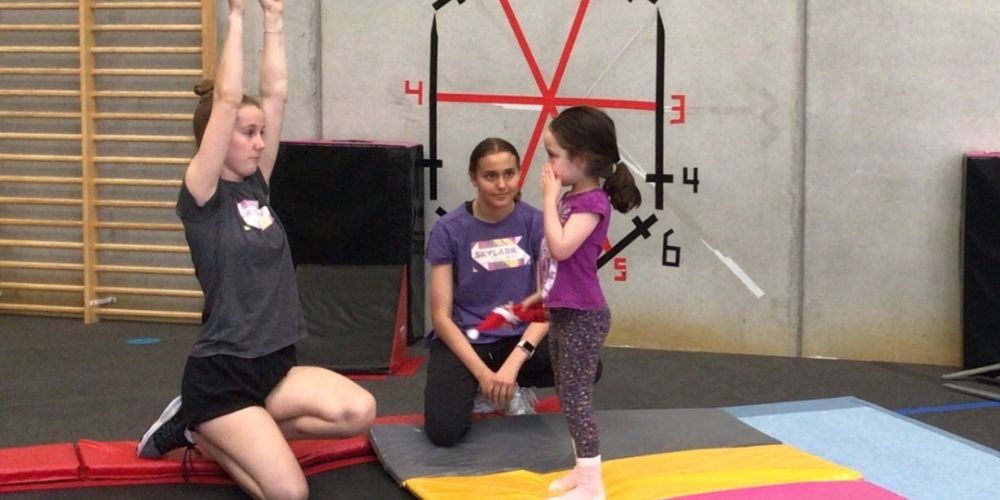
As a parent, being concerned about your child's screen time is natural. According to an Australian Institute of Family Studies article,
" Most Australian children spend more time on screens than is recommended. Estimates from primary research suggest only 17–23% of preschoolers and 15% of 5–12-year-olds meet screen-time guidelines. Screen time has also increased between 10 and 14, especially among boys. The increased screen-time types were electronic gaming for boys and TV, computer use and social networking for girls."
Excessive screen time has clear negative impacts on our children, and I understand that every parent can see these effects.
Some of these that I would personally witness at home are:
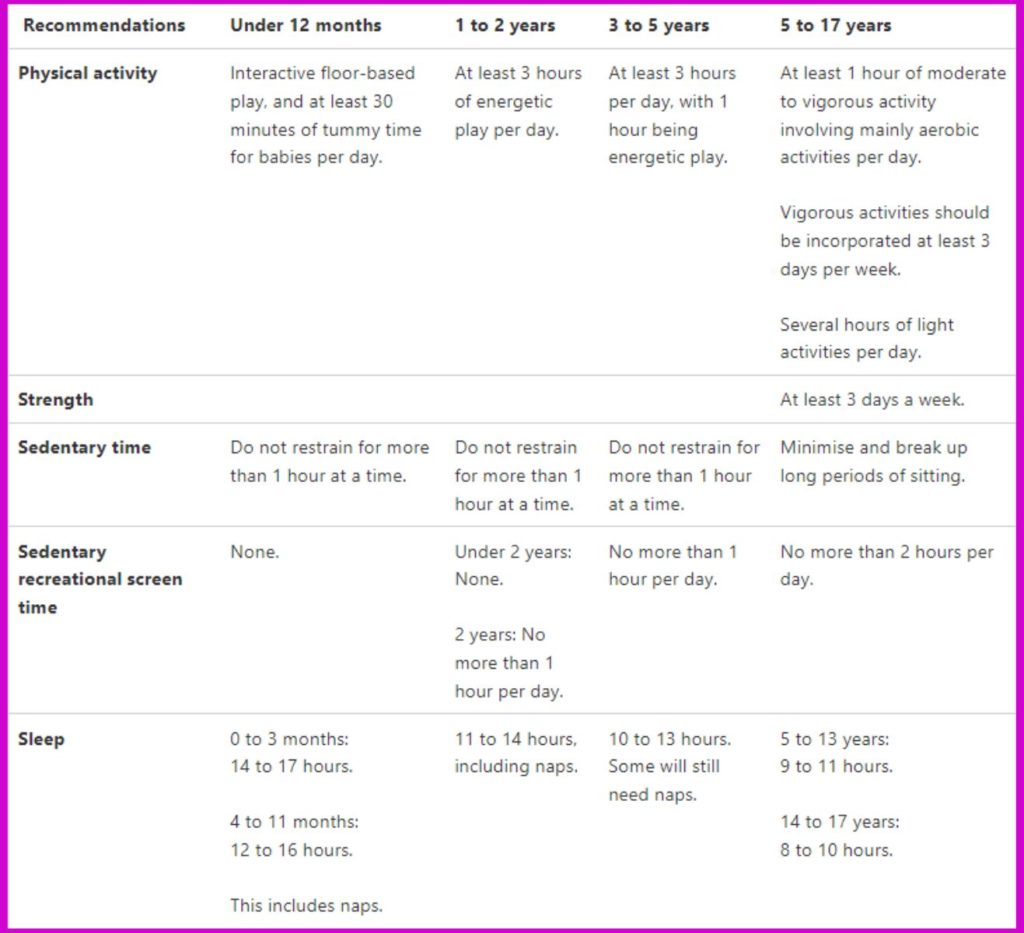
Have you heard of the 24-hour movement?
It's nice to know that the Australian government recognizes the importance of physical activity, sleep, and sedentary behaviour through the 24-hour movement guidelines. These guidelines emphasize the need for children and adolescents to balance physical activity, sedentary behaviour (such as screen time), and sleep for optimal health and well-being.
In fact, according to these guidelines, children aged 5 to 12 years should accumulate at least 60 minutes of moderate to vigorous physical activity every day while minimizing sedentary activities like screen time. Additionally, they should aim for 9 to 11 hours of uninterrupted sleep per night.
For adolescents aged 12 to 18, the guidelines recommend aiming for at least 60 minutes of moderate to vigorous physical activity daily, limiting sedentary behaviour, and aiming for 8 to 10 hours of sleep per night.
By following these guidelines and encouraging a healthy balance of physical activity, screen time, and sleep, we can support our children in leading active, healthy lifestyles.
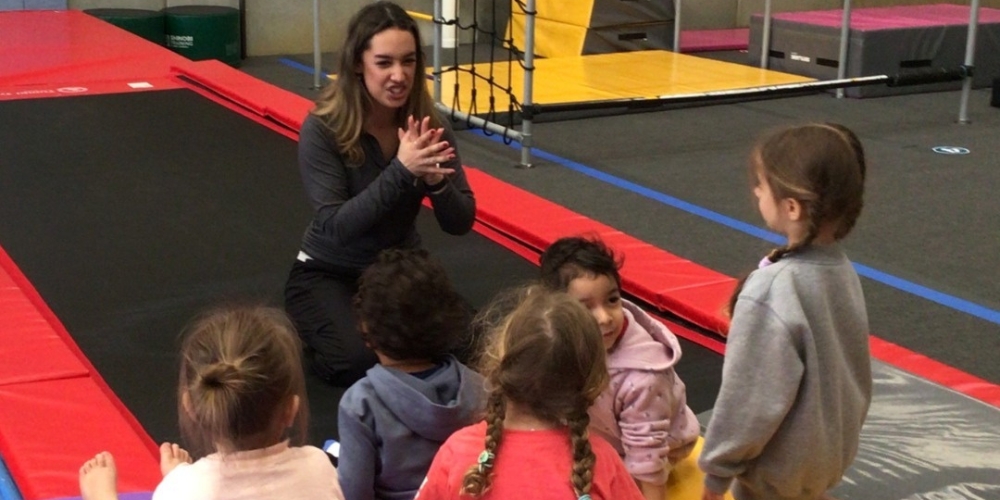
As a gymnastics instructor, I've witnessed countless benefits that gymnastics can bring to kids beyond just physical fitness. Here are seven key advantages:
Gymnastics isn't just about getting sweaty; it's about building a strong, resilient body from head to toe. I've watched kids transform their strength, flexibility, and stamina through gymnastics. From the little ones learning to hold a proper cartwheel to the older kids mastering complex routines, every achievement is a testament to their growing physical prowess. And the best part? They're having so much fun they don't even realize they're working out!
There's nothing quite like when a timid kid conquers their fears and shines on the gymnastics floor. I'll never forget the first time one of my students nailed a backflip after weeks of practice. The look of pure joy and pride on their face was priceless. Gymnastics has a magical way of boosting kids' self-esteem as they tackle new challenges and push their limits. Whether mastering a new skill or performing in front of a crowd, every accomplishment builds their confidence brick by brick.
Gymnastics classes aren't just about somersaults and handstands but also bustling hubs of friendship and camaraderie. I've seen kids form tight-knit bonds as they support and encourage each other through every twist and turn. Whether they're spotting each other during practice or cheering from the sidelines at competitions, gymnastics fosters a sense of community that extends far beyond the gym floor. Seeing these friendships blossom and grow with each passing class warms my heart.
Let's be real: gymnastics isn't for the faint of heart. It takes serious dedication and discipline to master those gravity-defying flips and twists. I've watched kids dig deep and push through fatigue and frustration to achieve their goals. Whether practising for hours on end or fine-tuning their technique with laser focus, gymnastics teaches them the importance of grit and determination. And when they finally nail that tricky routine? The sense of accomplishment is truly priceless.
Have you ever seen a gymnast effortlessly glide across the balance beam or stick a landing with pinpoint precision? Gymnastics isn't just about brute strength but finesse and control. I've seen kids develop incredible balance and coordination as they master the art of gymnastics. And the best part? These skills translate seamlessly to other sports and activities, giving them a competitive edge wherever they go.
From their first class, gymnastics teaches kids the importance of setting and working hard to achieve goals. I've seen kids light up with excitement as they inch closer to mastering a new skill or conquering a daunting routine. Whether aiming for a spot on the competition team or simply striving to improve their form, gymnastics gives them the tools to chase their dreams with confidence and determination.
Beyond the flips and tricks, gymnastics instills valuable life lessons beyond the gym floor. Kids learn resilience in the face of failure, perseverance in pursuing their goals, and time management as they juggle school, practice, and other commitments. These skills aren't just important for gymnastics; they're essential for success in all areas of life. As a gymnastics instructor, there's nothing more rewarding than watching my students grow into strong, confident individuals ready to take on the world, one cartwheel at a time.
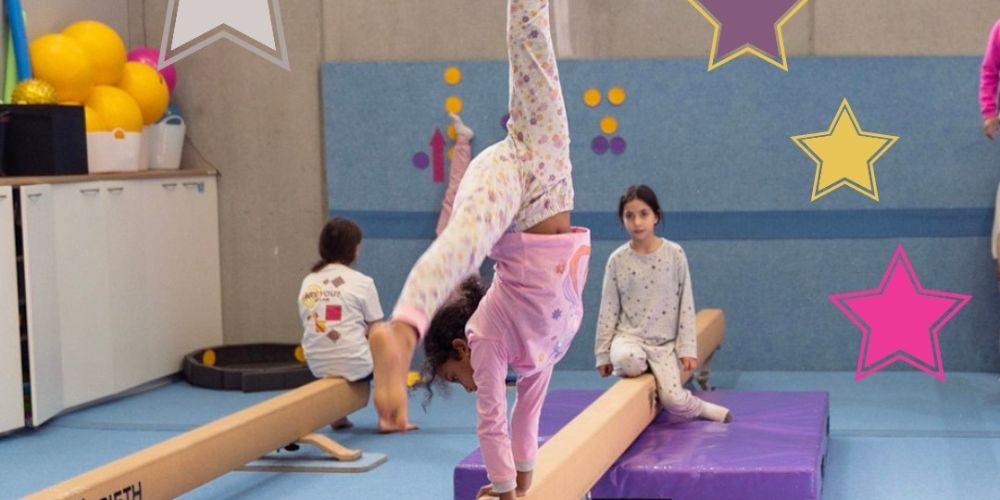
Okay, picture this: before we dive into all the cool flips and twists, we've got to get those muscles warmed up! It's like revving up a car before hitting the road. A good warm-up pumps blood loosens those stiff muscles and helps prevent nasty injuries. Plus, it gets the kids excited and ready to rock!
Who doesn't love rolling around like a human wheel? Forward rolls are not just fun – they're also super important for building coordination and body awareness. Plus, they're like a safety blanket for kids. If they ever take a tumble, they'll know how to roll out of it safely. It's all about learning to fall gracefully!
Cartwheels are like the bread and butter of gymnastics. They're all about grace, strength, and a lot of style. By breaking them down into steps, we're helping kids master the basics before they start adding their flair. It's all about building confidence, one step at a time!
Oh, the balance beam – every gymnast's best friend and worst nightmare! But seriously, walking on a narrow beam requires some serious focus and control. It's like walking a tightrope but way cooler. Plus, it's a great confidence booster once they conquer their fear of heights!
Swingin' from the bars like a monkey is every kid's dream. But it's not just fun and games – it's also building serious upper-body strength and coordination. Plus, there's something so satisfying about nailing that perfect rhythm and flying through the air like a superhero!
Now, this is where the real magic happens – the floor routine! It's like putting together a jumps, flips, and dance moves puzzle. Not only does it showcase their athleticism, but it also lets them express themselves and show off their personality. It's their time to shine!
Vaulting is all about power and precision. It's like launching yourself into the air and sticking the landing like a pro. But it's also about learning to trust your body and commit to the moment. Plus, who doesn't love the feeling of flying through the air?
Ah, the handstand – the ultimate test of strength and balance. It's like defying gravity and standing on your hands like it's no big deal. But it's also about building confidence and overcoming fear. Once they master the handstand, they'll feel like they can conquer anything!
Bouncing around on a trampoline is every kid's dream come true! But it's not just fun – it's also building some serious coordination and body awareness. Plus, it's a great way to burn off some energy and get those endorphins flowing!
And finally, we wrap it all up with a nice, relaxing cool-down stretch. It's like giving your muscles a big ol' hug after a hard day's work. Stretching helps prevent soreness or stiffness and keeps those muscles nice and limber. Plus, it's the perfect way to wind down and relax after a fun-filled gymnastics session!
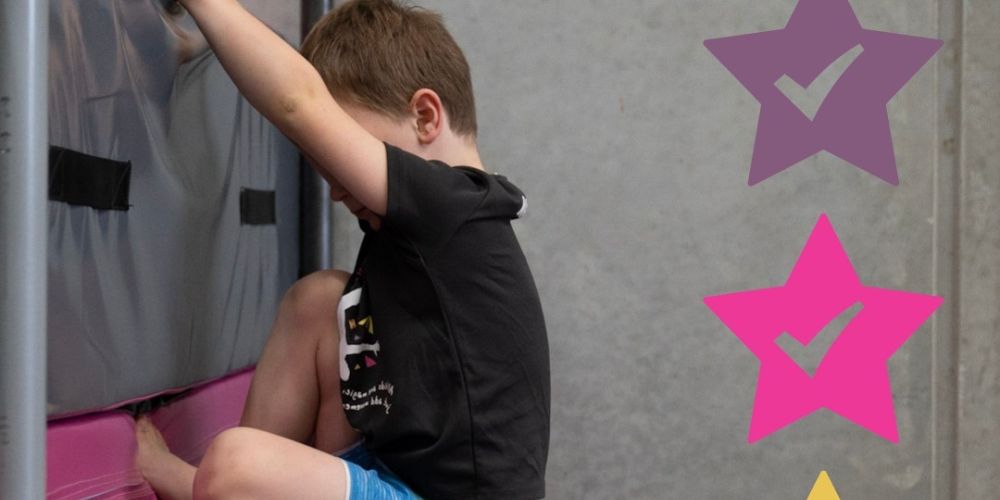
Start the day with a few gymnastics-inspired stretches. At home, we would start with reaching for the sky with arms, touching their toes to stretch their hamstrings and doing gentle twists to loosen up their spines. This helps wake up their muscles and prepares them for the day ahead.
Throughout the day, incorporate short bursts of gymnastics exercises as active breaks. Set a timer for every hour or so, and have kids do quick exercises like forward rolls, cartwheels, or jumping jacks to get their blood flowing and break up long periods of sitting.
Designate a specific time each day for "after-school gymnastics hour." During this time, kids can practice different gymnastic routines or skills they've learned, independently or with siblings. Make it a fun and interactive activity by playing upbeat music and setting up a makeshift gymnastics area in the living room or backyard.
Turn everyday chores into gymnastics-inspired activities. For example, have kids practice balance and coordination by walking across a "balance beam" made from a strip of masking tape on the floor while carrying a laundry basket. Or challenge them to do cartwheels or handstands while cleaning up their room. This is my favourite routine! Who would not want a helping hand while having fun, right?
Create games that incorporate gymnastics elements. For example, set up a scavenger hunt where kids must perform specific gymnastics skills at each location before moving on to the next clue. Or play "Simon Says" with gymnastics moves like jumps, rolls, and poses.
Dedicate one evening a week to family fitness night, focusing on gymnastics. Clear some space in the living room or basement and take turns leading each other through different gymnastics routines or exercises. It's fun to bond as a family while staying active and healthy.
Wind down at the end of the day with some calming gymnastics-inspired stretches. Encourage kids to do gentle stretches like butterfly stretches for their hips, cat-cow stretches for their spine, and child's pose for relaxation. This helps release tension from the day and prepares their bodies for a restful night's sleep.
While gymnastics primarily focuses on physical development, it can indirectly benefit academic performance by promoting discipline, focus, and time management skills. Regular physical activity has also improved cognitive function and academic achievement.
Many gymnastics programs offer inclusive classes or adaptations for children with disabilities. These programs promote participation, skill development, and confidence in a supportive and accommodating environment. Contact local gymnastics facilities or organizations specializing in adaptive sports for more information.
Encourage your child to set personal goals, celebrate achievements, and maintain a positive attitude towards challenges and setbacks. Provide support and encouragement and allow them to take ownership of their gymnastics journey and pursue their passions within the sport.
It's common for children to experience fear or anxiety when learning new gymnastics skills. Encourage open communication with your child to understand their concerns and provide reassurance and support. Break down the skill into smaller, manageable steps and gradually build their confidence through repetition and positive reinforcement. Consider seeking guidance from a qualified gymnastics coach or sports psychologist if needed.
Alright, we've covered a lot of ground discussing how to weave gymnastics into your child's daily life. From backyard adventures to family challenges and everything in between, there's no shortage of ways to keep those little ones flipping, twisting, and tumbling away from screens. Remember, it's not just about mastering skills; it's about fostering a love for movement, creativity, and healthy living.
So, whether you're setting up an obstacle course in the living room or transforming your backyard into a gymnastics arena, have fun, stay safe, and let those kiddos shine like the little gymnastic stars they are! Here's to many more days filled with laughter, learning, and boundless energy. Keep those bodies moving, and you might discover the next Olympic champion right in your home!
If you've ever wondered about taking up gymnastics or enrolling your child in classes, one burning question probably comes to mind: "How much is this going to cost me?" Well, as both a gymnastics coach and the proud owner of Skylark Sports, I've seen this question pop up more times than I can count. And guess what? I'm here to give you the lowdown.
Gymnastics classes aren't just about mastering flips and twists and building strength, flexibility, and confidence. But let's be real; we've all got budgets to consider.
But before we get into the dollars and cents, let me say this: the benefits of gymnastics far outweigh the costs. Whether dreaming of Olympic glory or simply looking for a fun way to stay fit, gymnastics has something for everyone.
So, if you're curious about how much gymnastics classes will cost, keep reading, as we will share some guides about what to expect.
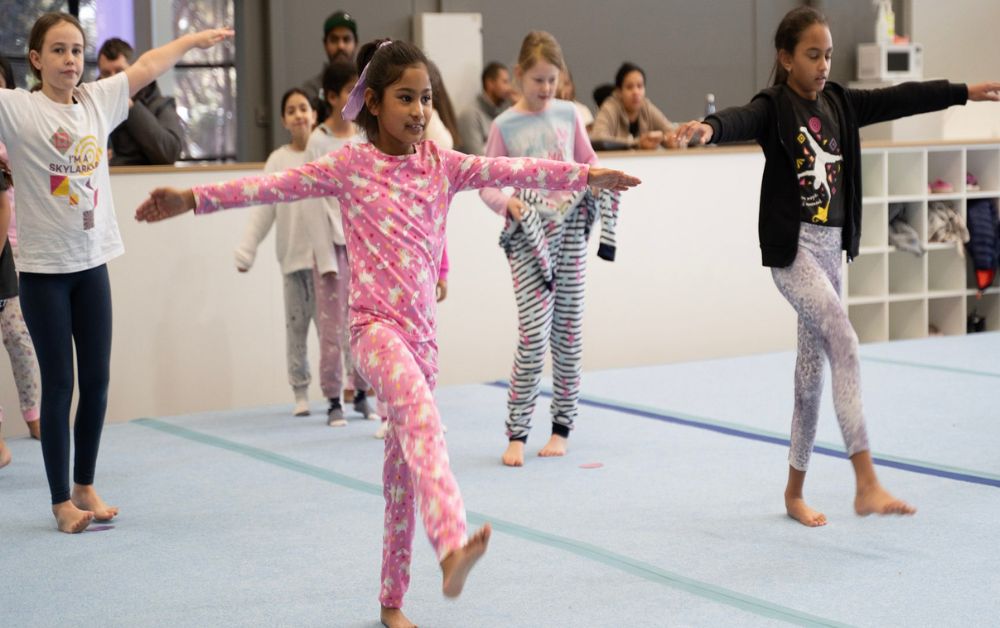
So, how much do gymnastics classes typically cost down under? In my experience as a gymnastics coach here in Australia, you're looking at roughly $15 to $30 per class for recreational sessions. These are great for beginners, focusing on getting those fundamental skills nailed down - think balance, coordination, and strength.
If you're ready to step up your game and dive into more advanced or competitive classes, expect to shell out a bit more, maybe around $30 to $50 per session. These classes often involve some serious training and specialised coaching. They might come with extra costs like competition fees and travel expenses.
But hey, don't let the numbers scare you off! Many gyms offer discounts for multiple classes or siblings, so it's worth asking about any deals they have. After all, investing in gymnastics isn't just about the dollars - it's about investing in yourself or your child's physical fitness, skill development, and all-around awesomeness.
When it comes to preparing for gymnastics trainings, these class fees are essential. They pay for everything, including coaching wages and gym rentals. Class fees can vary depending on the gym's reputation and location, so it's important to ask about available prices before committing.
Although most gyms provide standard equipment like bars and mats, you may need to purchase some personal goods like grips, leotards and possibly even your tumbling mat or beam for at-home practice. These fundamental instruments of the profession will enable you to hone your abilities safely.
Be ready to pay more if you want to participate in gymnastics competitions. Competition fees, lodging, and transport costs may quickly increase, particularly when attending events out of town. To prevent any unforeseen financial difficulties, it is advisable to budget for these costs well in advance.
Although most gym memberships include group courses, some gymnasts pay extra for private coaching sessions to receive more individualised attention or hone their skills. Suppose you're serious about improving your gymnastics. In that case, private coaching is something you should think about, even though it's an additional expense.
Many gymnastics clubs and associations impose membership fees to pay for administrative expenses and access specific resources or perks. These costs could be monthly or yearly, so account for them in your spending plan.
Travel costs can add up quickly, whether you're travelling to out-of-town events, workshops, or specialised clinics. Meals, lodging, and transportation must all be considered while organising these gatherings.
Depending on your needs and objectives, you may need to spend money on extra services like physical therapy, injury prevention plans, or nutritional counselling. These services may only sometimes be required, but they can be important for your general well-being and gymnast performance.
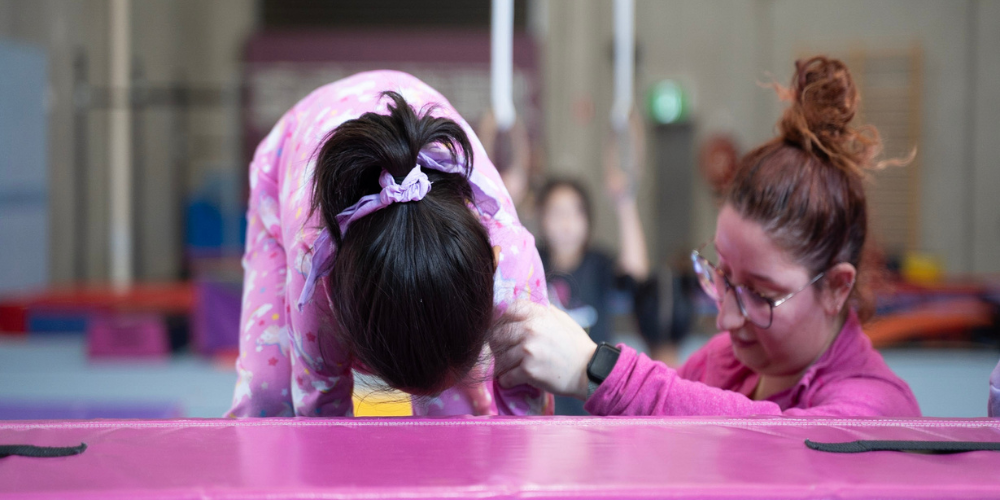
Now, let's talk about making gymnastics more affordable without compromising quality or safety. As a coach who's seen it all, I've got some tips to help you navigate the financial side of this fantastic sport:
Be sure to not limit yourself to the first gym you come across. Spend some time exploring the offerings of several different locations. There may be less-priced gyms out there that are just as good.
You can study gymnastics in these classes without worrying about fancy routines or contests. Compared to classes where you compete against other students, they are typically less expensive.
Gyms occasionally offer discounts for repeated class enrollment or payment in advance of several months. It's worthwhile to enquire about any current sales or promotions.
Purchasing the least expensive equipment is a good idea, but occasionally, making a small upfront investment in high-quality gear may result in financial savings. You won't need to replace good gear as frequently because it lasts longer and performs better.
Gymnastics equipment can be pricey, but you can often find gently used gear at a fraction of the cost. Check online marketplaces, local gymnastics communities, or your gyms lost and found bargains.
If your gymnast is involved in competitions, consider which events to participate in to minimise travel and accommodation costs. Look for local or regional competitions to save on expenses.
Investing in additional lessons is only sometimes necessary to advance your gymnastics abilities. Create a secure area at home where you may dedicate your time to practising fundamental stretches and motions.
Always be reassured to ask for assistance if you need help paying for your gymnastics classes. For families in need, several gyms provide financial assistance or scholarships. If you need help, it always helps to ask about your alternatives.
Seeking referrals from friends, relatives, or nearby sports groups is a good place to start. Lookup reviews online and visit various gyms to see classes and get to know the teachers.
Most gyms provide classes for toddlers and people of all ages. Though age and ability level may be considered when dividing classes, there are usually no hard age limits.
When comparing gymnastics programs, consider factors such as the quality of instruction, the gym's reputation and facilities, the variety of classes offered, and the overall value of the cost.
While gymnastics can be a significant financial investment, many families find that the benefits, including physical fitness, skill development, confidence building, and personal growth, outweigh the costs. It's essential to weigh the benefits against the expenses.
To summarise, gymnastics can seem pricey, but it's worth it. Whether you're just starting or you've been at it for a while, there are ways to make it more affordable. Look for cheaper classes, use discounts, and plan smart for extra costs like gear and competitions.
But remember, gymnastics isn't just about money. It's about getting fit, learning new skills, and feeling confident. So, don't let the cost scare you off. With a little effort and budgeting, you can enjoy all the awesome benefits of gymnastics without spending too much. Keep flipping, jumping, and having fun!
Every gymnast knows what GK means, and to answer your question, GK means "Gymnastics Kinetics." It's more than just a brand or a label on our gear in gymnastics classes; it represents a world of dedication, passion, and excellence in gymnastics.
Do you see those lovely leotards that Simone Biles wears? Chances are, many of them are from GK Elite Sportswear. These leotards aren't just pieces of clothing; they're like a second skin to us gymnasts. When we put on a GK leotard, it's not just about looking good (although that's certainly a plus!), it's about feeling good and performing at our best.
GK Elite is where athletes find the world's leading brand of gymnastics apparel, which has been serving them for over 40 years. GK takes pride in offering unparalleled variety, quality, fit, and service, all dedicated to supporting athletes' gymnastics journeys. From grassroots programs to partnerships with over 10 Olympic athletes, GK has been committed to the sport since the beginning, investing millions into its growth globally.
When athletes wear GK, they're in good company. Olympians like Simone Biles, Suni Lee, Jade Carey, Jordan Chiles, and Yul Moldauer have all trusted GK to outfit them, and some have even designed their Signature Collections with the brand, showcasing their unique styles and personalities.
The brand proudly sponsors many top collegiate gymnastics and national teams from Canada, Australia, and the Netherlands. As the exclusive competition and training attire provider for USA Gymnastics National Team athletes, GK supports athletes at every level of their journey.
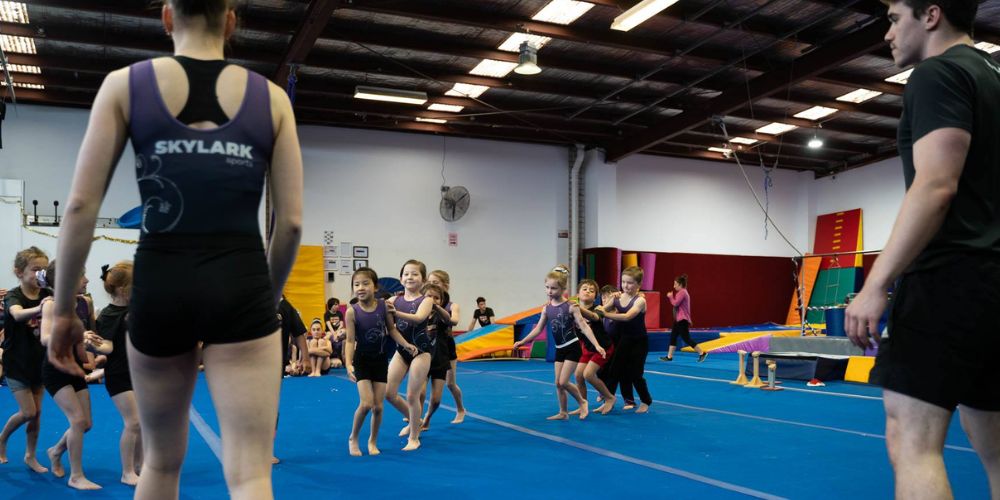
In the field of gymnastics, there are a few typical myths that come up when discussing GK. Let's dispel some of the misunderstandings:
One of the most widespread myths in gymnastics is that "GK" stands for something different. Some could misunderstand its meaning and importance if they mistake it for other acronyms or terminology used in the sport.
Another myth is believing that "GK" is only an acronym for a phrase used in gymnastics. Although GK is a well-known brand of gymnastics clothing, some people could erroneously think that the name is merely a synonym for anything else in the sport.
Although GK is mostly recognised for its superior gymnastics clothing, such as leotards and training equipment, some individuals might need to know the company's wider influence and contributions to the gymnastics community. GK supports gymnasts at all levels with partnerships, sponsorships, and more than simply clothes.
It's a common misperception that premium gymnastics clothing, such as GK, has to be expensive. Though GK Elite Sportswear is renowned for its exceptional quality, gymnasts of all skill levels may afford to purchase from the business because of its variety of options.
A common misconception is that GK clothing is exclusively for competitive athletes or top gymnasts. GK has many products for gymnasts of all ages and abilities, from amateur hobbyists to future Olympians.
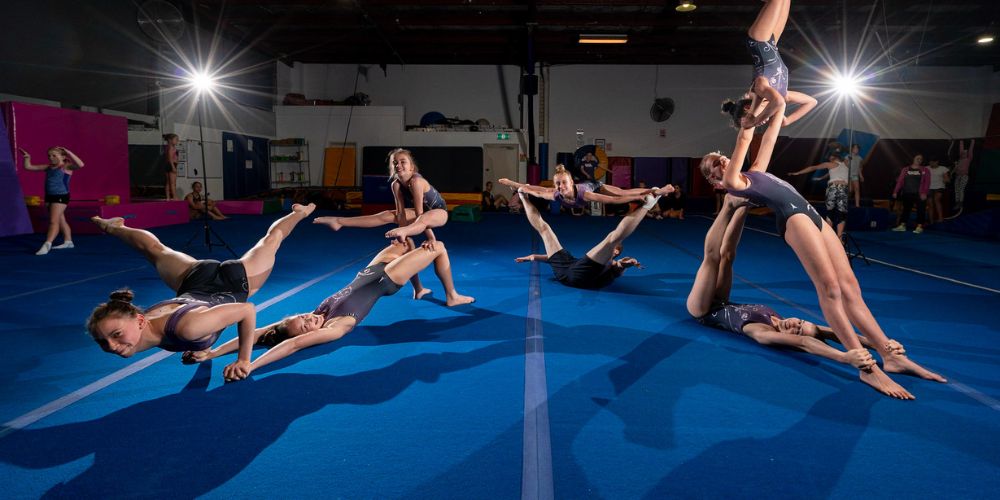
Clearly, leotards and other gymnastic gear are some of the things that make a performance stand out. But have you ever stopped to think about why they're so crucial?
Without such flashy leotards, a gymnastics routine wouldn't be the same! The judges and the audience are captivated by the lively colours, elaborate patterns, and sparkling decorations that add flair to every move.
Your attire serves as a creative canvas. This is your opportunity to present your individuality as a gymnast as a person. Your leotard allows you to express yourself and shine on the mat, whether your style is bright designs, elegant motifs, or something entirely different.
Like a beautiful suit or flowing gown, your gymnast attire elevates your performance to a more polished level. It presents you as someone who has given your appearance some time and attention, which sets the tone for a polished and memorable act.
Your leotard is made to support your movements and improve your performance, below all the bling and glamour. The ideal balance of comfort, flexibility, and support makes it easy to perform gravity-defying twists and flips.
For sponsored athletes, your outfit is more than just clothing—it symbolises partnership and support. By proudly wearing your sponsor's logo, you're representing their brand and showcasing the quality and innovation of their products to the world.
While many gymnasts, including elite athletes like Simone Biles, wear GK Elite leotards, it's not the only option. Gymnasts may choose from various brands based on personal preference, sponsorship agreements, and availability.
Absolutely! GK Elite Sportswear offers gymnastics apparel for athletes of all levels, from recreational enthusiasts to competitive gymnasts. You can purchase GK leotards and other gear directly from their website or authorised retailers.
GK offers custom design services for gymnasts and teams looking to create personalised leotards. Whether you're representing a gym, club, or national team, GK can work with you to bring your unique vision to life.
Yes, GK Elite Sportswear is an official partner of USA Gymnastics and provides competition and training attire for USA Gymnastics National Team athletes. The brand also sponsors various gymnastics events and initiatives globally.
So there you have it —answers to some common questions about what GK means in gymnastics. Whether you're a seasoned gymnast or just getting started, understanding the significance of GK Elite Sportswear can help you confidently navigate the world of gymnastics apparel.
From its reputation for quality and innovation to its support for athletes at all levels, GK Elite Sportswear has impacted the gymnastics community. Whether you wear GK leotards or other brands, the most important thing is finding gear that makes you feel comfortable, confident, and ready to shine on the mat.
Hey there, Skylark Families!
Hope you're all doing fantastic! We've got some exciting news to share with you all. As part of our commitment to progress over perfection, we're thrilled to announce the upcoming "progress checks" happening at Skylark Sports These checks are all about celebrating your child's growth and development in a supportive and encouraging environment.
What are Progress Checks?
Progress checks are scheduled skill assessments designed to track your child's advancement in their training. They're like little milestones that help us understand your child's strengths, areas for improvement, and overall progress within our programs. Our amazing coaches will be right there alongside your child, providing support and guidance every step of the way.


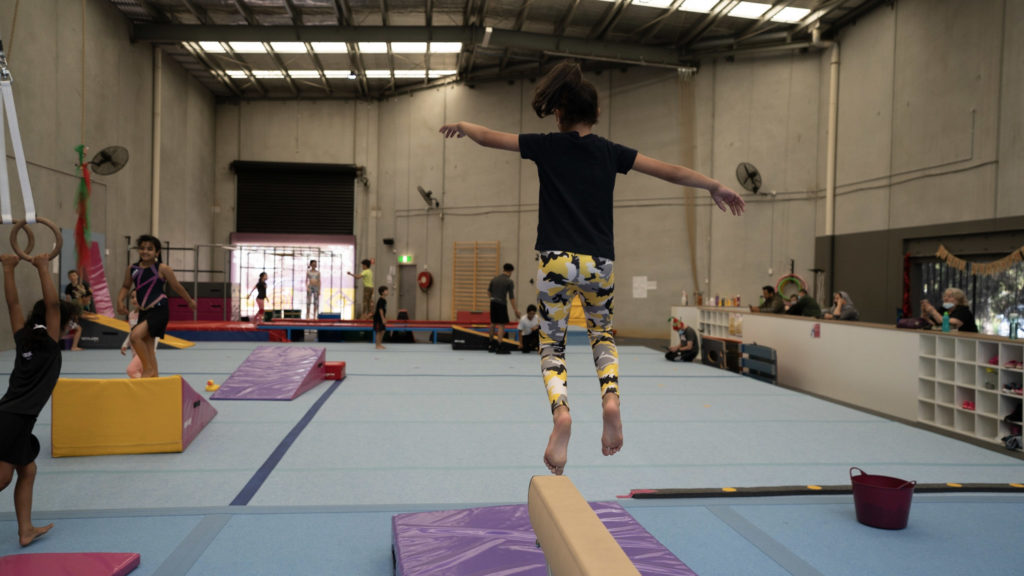
Why Celebrate Progress?
At Skylark Sports, we're all about celebrating progress because we know it's the key to unlocking your child's full potential. Here's why it's so important:
Our Promise to You
As we gear up for the upcoming progress checks, know that our coaches are fully committed to providing a nurturing and supportive environment where every child feels valued and encouraged. Whether your child is mastering a new gymnastics skill or conquering a ninja obstacle, we're here to celebrate their achievements every step of the way.
How You Can Help
We encourage you to celebrate your child's progress at home and reinforce the importance of effort, resilience, and perseverance. Your support and encouragement mean the world to them!
Mark Your Calendars
Don't forget to mark your calendars for the following progress check dates:
Wrapping Up
As we embark on this journey of growth and progress together, let's celebrate the achievements of every child at Skylark Sports. Together, we can inspire a generation of confident, resilient, and empowered young athletes.
If you have any questions or concerns about the progress checks or anything else, please feel free to reach out to us anytime.
Thanks for being part of the Skylark Sports family!
Have you ever heard the saying "gymnastics is for everyone"? Well, it's true! But wait, there's a tiny exception... Yep, you guessed it – our littlest explorers who are just starting to navigate the big wide world.
Don't worry if you can't picture them doing Olympic-level flips just yet. We've got loads of fun activities tailor-made for those curious toddlers, imaginative 4-year-olds, and adventurous 5-year-olds.
As the proud owner of Skylark Sports, I'm here to tell you that if you want your kids to have a blast while learning new skills, you're in the right place.
So why wait? Let's dive into the world of gymnastics together and find out some of our favourite activities to share with kids from toddlers to 5 years old.
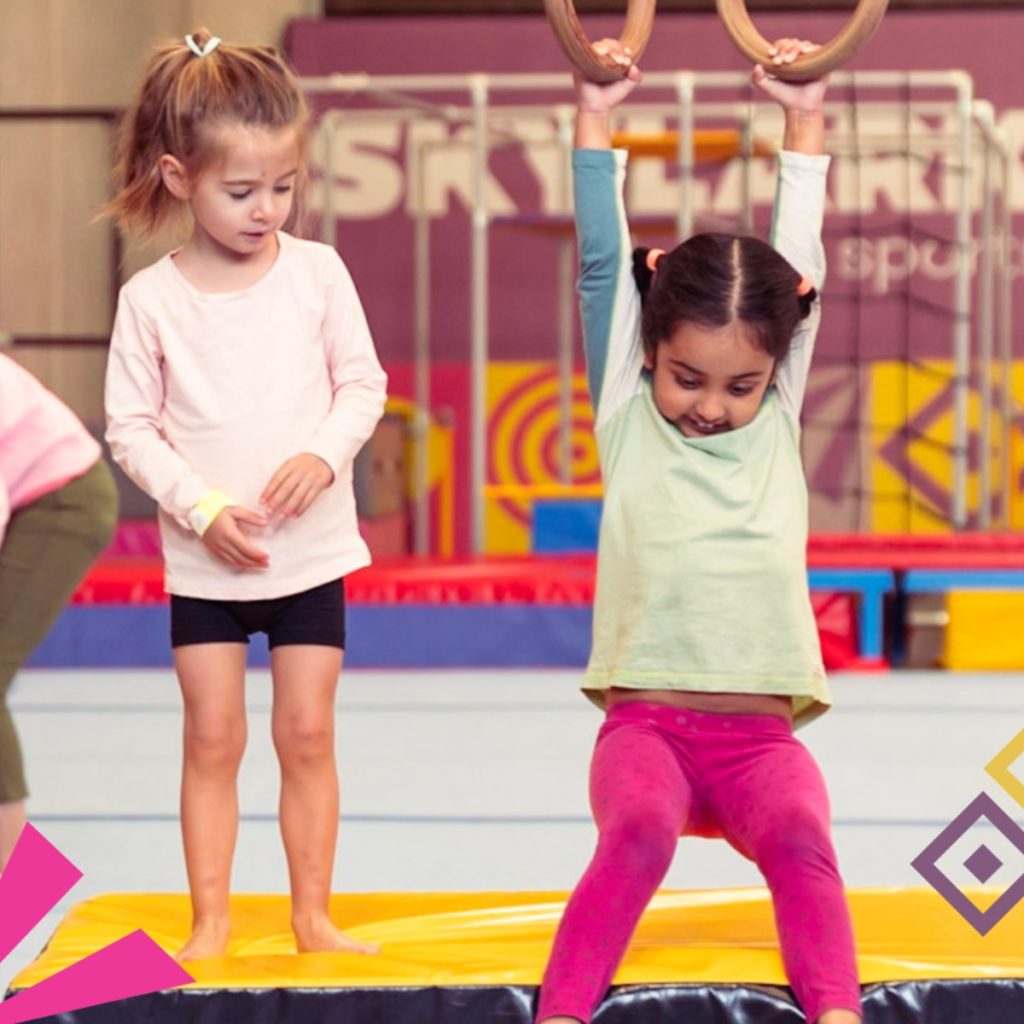
If you're going to ask me, as someone who has been doing gymnastics since I was young, it's all about the thrill of defying gravity and pushing your limits in ways you never thought possible.
Experience-wise, as a gymnastics coach, kids find gymnastics exciting because it's a perfect blend of challenge and fun.
I remember one time, this 5-year-old little guy told me he was more excited about our gymnastic sessions than his classes (which we do not encourage!).
It was heartwarming to see his enthusiasm and passion for the sport, and it just goes to show how much joy and excitement gymnastics can bring to young kids.
What age do we consider our little ones as toddlers?
Toddlers are usually considered children between the ages of 1 to 3 years old.
Toddlers are natural explorers, and gymnastics provides an excellent opportunity to tumble and play while learning important motor skills.
Here's what we do to introduce basic gymnastics moves to toddlers:
Rolling: We encourage moderate forward rolls on soft mats or cushions. This allows children to become comfortable with the action and develop body awareness.
Balancing: To help toddlers practise walking and balancing, we set up low balance beams or use masking tape to form straight lines on the floor. The goal is to increase their stability and confidence gradually.
Jumping: We provide a safe environment for toddlers to practise jumping on little trampolines or jump mats. This helps students improve leg strength and coordination while having fun!
Incorporating music and games into gymnastics activities can make the experience even more enjoyable for toddlers.
And when it comes to enhancing the gymnastics experience with fun songs and games, here's what we love to do:
Circle Time and Music: We begin each session with circle time, where toddlers can dance and move to exciting music. It gets them fired up and ready to engage in gymnastics activities.
Action Songs: We sing songs with actions like "Head, Shoulders, Knees, and Toes" or "The Hokey Pokey" and encourage toddlers to participate. It's a great method to reinforce basic gymnastics skills while keeping children engaged.
Parachute Games: We bring out a colourful parachute for activities like "Popcorn" and "Waves," which allow toddlers to jump and move in different directions. It's an excellent approach to improve coordination and social connection.
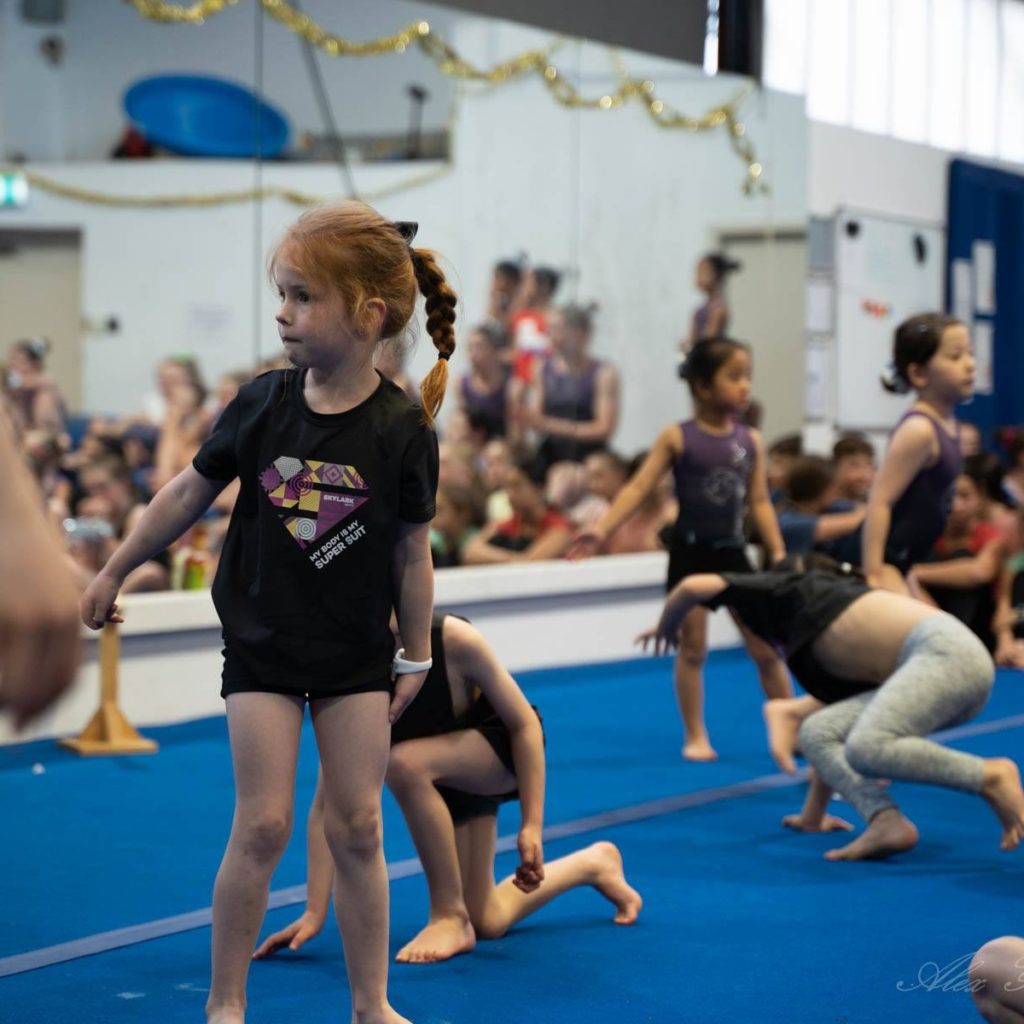
Let's talk about the awesome gymnastics skills our 4-year-old gymnasts can master!
Here's what we focus on to keep them engaged and progressing:
Forward Rolls: We focus on perfecting forward rolls, beginning with modest tucks and graduating to straight rolls. It's all about developing confidence and physical control.
Jumping: We teach a variety of jumps, such as tuck jumps and star jumps, to help children improve leg strength and coordination. Plus, it's a lot of fun to see them leap about the gym!
Balance Beam Basics: We begin with low beams and teach children fundamental balancing strategies, such as walking forward and backwards. It's an excellent approach to enhance their balance and concentration.
Now, let's talk about how we keep the fun going with group games and challenges:
Mini Gymnastics Circuits: We set up mini circuits with different stations for them to rotate through, like jumping on a mini trampoline, crawling through tunnels, and balancing on beams. It keeps them moving and engaged!
Partner Activities: We pair them for partner stretches, mirror exercises, and fun challenges like wheelbarrow walks. It's a great way to promote teamwork and cooperation while having a blast.
Creative Challenges: We encourage them to get creative with gymnastics by inventing their routines or trying new skills. It's all about fostering their creativity and confidence in a supportive environment.
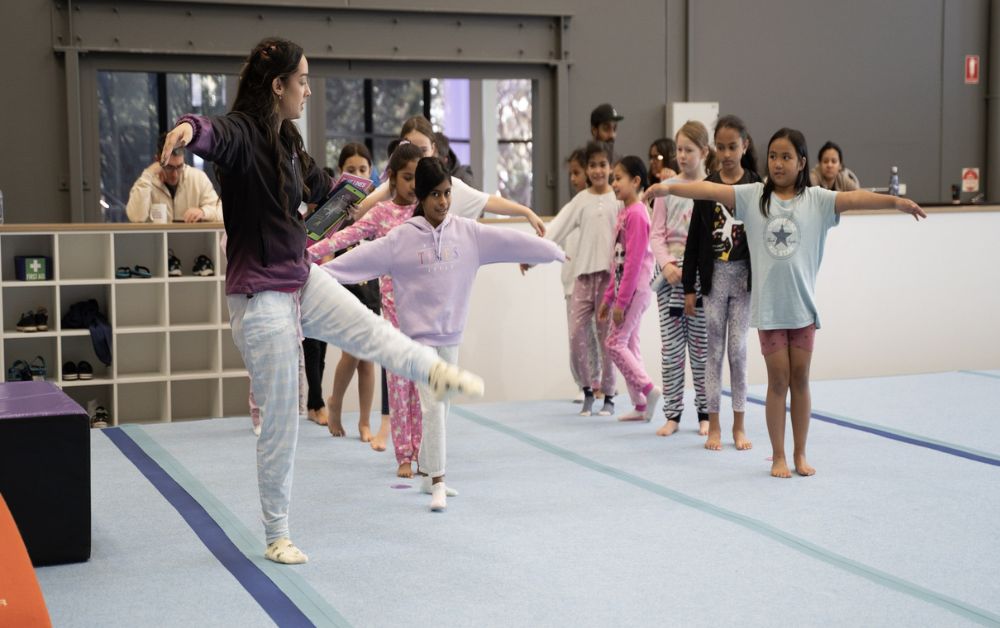
Alright, let's dive into some exciting gymnastic activities that are perfect for our 5-year-old gymnasts:
Cartwheels: We begin by teaching them how to do cartwheels and working on their strength and flexibility. It's a classic gymnastics move that always gets kids pumped!
Forward Roll to Stand: We teach a more advanced version of the forward roll, in which they roll and stand up without using their hands. It's a pleasant task that enhances coordination and body control.
Handstands: We teach them how to execute handstands against a wall, emphasising good alignment and balance. It's an excellent technique to increase upper-body strength and confidence upside down.
Beam Routines: We introduce lengthier beam routines incorporating a range of abilities, such as forward and backwards walking, kicks, jumps, and twists. It's fun to test their balance and coordination while creating a routine they'll be proud to perform.
Vault Jumps: We set up a tiny vault and taught them fundamental jumping skills, such as straight and tuck jumps. It's an exciting activity that helps children build power and explosiveness.
Safety is always a major issue in gymnastics for young children. Here are some important safety guidelines to keep in mind.
Children can begin gymnastics as early as toddlerhood. Still, it is critical to select a programme that provides age-appropriate activities and emphasises enjoyment and development over competitiveness.
Ensure your child is enrolled in a reputable gymnastics programme with qualified teachers who prioritise safety. Additionally, observe the instructors' safety advice and confirm that the gym has sufficient safety precautions.
Your child should bring a water bottle, comfortable clothing, and any necessary safety gear the gym provides.
Gymnastics classes for young children typically range from 45 minutes to 1 hour in duration.
Gymnastics is more than a sport; it is a journey of discovery and development for our children. As they navigate the exciting world of flips, jumps, and balances, kids develop physical strength, coordination, perseverance, confidence, and a lifelong passion for movement.
So let's keep nurturing their passion, celebrating their accomplishments, and marvelling as they soar to new heights, both in the gym and out. Here's to the love of gymnastics and the limitless possibilities it opens in every child!
We all want the best for our children, so we're looking for activities to help them grow and thrive despite our busy lives.
One fantastic option? A children's gym program. But with so many choices out there, it can be overwhelming.
I totally get it! We got to talk to many parents who wish to seek the ideal path for their little ones. As a gym instructor and a proud owner of Skylark Sports. I understand the importance of finding the perfect fit for your child's growth journey.
That's why we list all the important things parents should know when choosing the right gym program for their kids.
Let's get down to it!
First of all, why do kids need exercise?
Exercise is super important for kids, and here's why. First, it keeps their bodies in tip-top shape – muscles, bones, all that good stuff.
Actually. the Centers for Disease Control and Prevention recommends that children and adolescents ages 6 to 17 do 60 minutes or more of moderate-to-vigorous physical activity daily.
You know how kids are like little bundles of energy? Well, exercise helps them use that energy wisely. It's like a magic spell for their heart and lungs, ensuring everything works smoothly.
But hold on, it's not just about the body; exercise does wonders for the brain, too! It helps them focus better in school and puts a big smile on their faces.
So, whether it's a tag at the park or a game of soccer, giving kids exercise is like handing them a secret potion for a healthy and happy life!
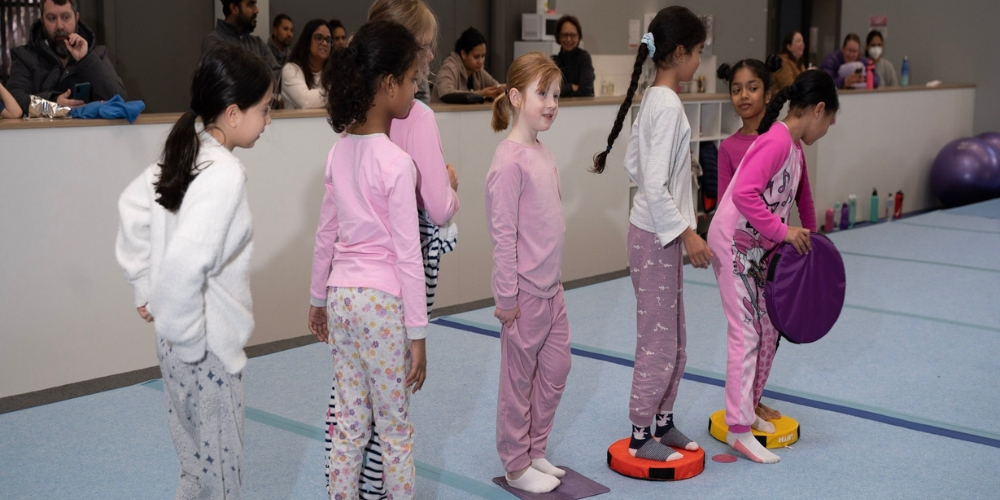
The first step in choosing a children's gym program starts with considering your child's age. Look out for programmes that match their developmental stage, ensuring the exercises are interesting and appropriate for their level of physical ability. Customised programmes help create a welcoming and encouraging learning atmosphere where your child can flourish at their speed.
It's important to have instructors who know their stuff. Choose programs with teachers who have certificates and know a lot about working with kids. These instructors teach well, ensuring your child feels safe and encouraged to do their best.
Make sure the gym is a safe place for your child. Check if they have things like safe equipment and plans for emergencies. When your child is safe, they can have more fun confidently exploring and doing activities.
A good gym program should have a learning plan. Look for a program that helps your child learn new things step by step. This way, they can feel proud as they get better at gymnastics.
Every child is special, and the gym program should celebrate that. Choose a program where all kids, no matter what, feel happy and encouraged. This makes the gym a friendly place for your child to make friends and learn together.
See if the program wants parents to join in. Some programs let parents be part of the fun, watching their child learn and helping out. This can make the gymnastics experience even better for you and your child.
Check whether the programme allows your child to observe a class before registering. This allows them to determine whether they enjoy it and if it suits them. You can use it to determine whether the programme is appropriate for your child.
Think about how the classes fit into your day. A good program should have times that work well with your family's schedule. This way, your child can go to classes regularly and enjoy learning gymnastics.
Choose a program that talks to parents a lot. It's good when they tell you how your child is doing, what's coming up, or if there are any changes. This way, you can be part of your child's gymnastics journey and sort out any questions or worries.
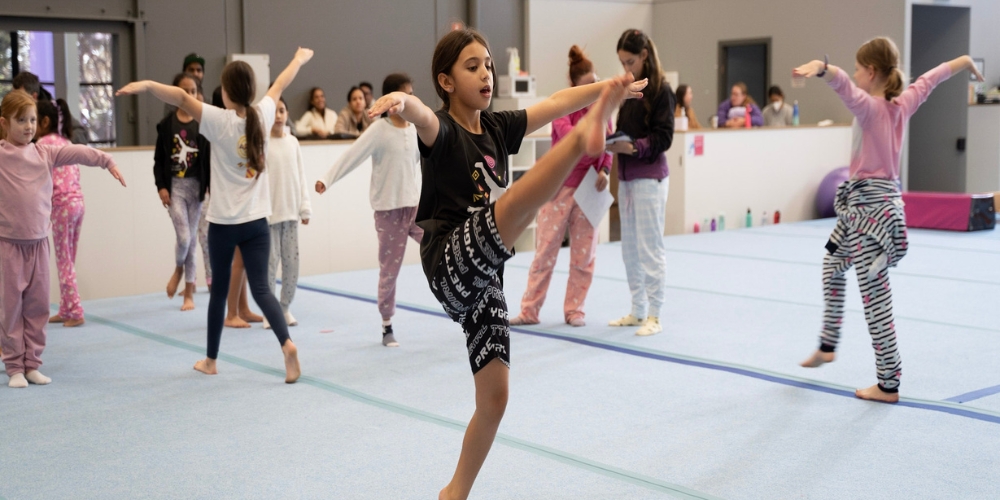
In a children's gym program, you can expect a mix of fun and skill-building activities that cater to young participants' unique needs and interests. Here are some activities commonly found in such programs:
Prepare for an immediate surge of energy to fill the room! Your children will jump into energetic warm-up activities combining movement, stretches, and unbridled excitement. It's the ideal start to prepare those tiny bodies for their upcoming gymnastics trip.
Expect a mini-gym boot camp! Your kids will learn the fundamentals of gymnastics, such as how to balance on beams, tumble like pros, and master their first jumps and rolls. It's a pleasant journey into gymnastic foundations rather than merely exercise.
Imagine your children making their way through entertaining obstacle courses. Beyond physical demands, these courses improve students' coordination, agility, and problem-solving abilities. Every session becomes an exhilarating adventure with challenges to overcome and victories to cherish.
Get ready for a rush of creativity! Your children will discover new ways to express themselves through movement, from incorporating dance aspects to allowing their imaginations to run free. It involves more than just following instructions; it involves discovering their rhythm.
As your child's gymnastics improves, they will be introduced to bars, beams, and vaults. Fear not; our skilled instructors will be there to transform this gymnastics equipment into tools for enjoyment and skill development. It's a trip of discovery led by skilled guides.
Expect teamwork to take centre stage! Cooperative activities will get your kids working together, strengthening social skills and teaching them the importance of completing goals as a group. It's not just about individual triumphs but the satisfaction of collective success.
Flexibility is key! Stretching activities will become a regular part of your child's routine, promoting healthy joints and increasing motion flexibility. It's about keeping those small bodies handy and ready to go.
Your little star might have the chance to shine! Mini-performances or showcases allow them to demonstrate their newly acquired talents, boosting confidence and providing a source of pride for you and them. It is a celebration of growth and accomplishment.
As the session ends, there is a brief moment of tranquillity. The cool-down part includes gentle exercises and relaxation techniques, ensuring your children leave with a grin and a positive attitude. It's the ideal way to wrap up an exciting and enjoyable gym session.
Many programs cater to various age groups, starting as early as toddlerhood. Check with the specific gym to find a program tailored to your child's age, ensuring the activities are engaging and suitable for their developmental stage.
Yes, many programs offer trial classes. This allows your child to experience the gym environment and the teaching style and determine their level of interest. It's a great way to ensure the program aligns with your child's needs and preferences.
Safety is a top priority. Look for programs with certified instructors, proper safety measures, and well-maintained equipment. Ensuring a secure environment allows your child to confidently explore and enjoy activities.
Choosing the right children's gym program doesn't have to be rocket science. Remember to consider your child's age, the expertise of instructors, safety measures, and the overall vibe of the program.
It's not just about flips and rolls; it's about building confidence, having fun, and creating a positive environment for your little one to thrive. Whether trying out a trial class or getting involved in their gym adventures, find a program that suits your family's needs.
Hey there, fellow parents and guardians! If you're like me, you're constantly looking for activities that entertain your little ones and contribute to their overall development.
Well, let me tell you, I stumbled upon something incredible – gymnastics for 3-year-olds! As a gymnastics coach and proud owner of Skylark Sports, I've witnessed firsthand the magic of these pint-sized dynamos stepping into the world of mats, bars, and beams.
In this blog, let me explain why you don't have to be scared to let your toddler start gymnastics as early as three!'

Absolutely! Starting gymnastics at three is possible and can be incredibly beneficial for your toddler. Children are like little sponges at this age, soaking up new experiences and skills.
Three-year-olds are in a critical developmental stage, and gymnastics can greatly impact their physical and intellectual development. Toddlers' inquisitive brains and active bodies are perfectly suited to the gymnastics environment, thoughtfully designed to correspond with their developmental milestones.
Recognising when your little one is interested in gymnastics for kids can be a delightful journey of observation and discovery. I would often hear moms during registration for kinder gym classes. "This kid is turning our home into a gymnastics playground!"
It's those moments when you notice your child attempting somersaults on the living room rug or mimicking balance beam routines using the sofa arm.
But how can you be sure that it's more than play? Here are a few signs that might indicate your little one has a budding interest in gymnastics:
It could be a sign of genuine interest if your child is always eager to watch gymnastics on TV or is fascinated by older kids practising at the local gym. Their eyes light up, and they may even try to mimic the moves they see.
Gymnastics enthusiasts tend to be in constant motion. If your little one is always on the move, trying out flips, jumps, or cartwheels whenever they can, it could clearly indicate a budding interest in gymnastics.
Listen in on their playtime conversations. Suppose you catch them pretending to be gymnasts with imaginative commentary about their routines. In that case, it's a strong sign that gymnastics is capturing their imagination.
Some children naturally demonstrate flexibility and coordination from an early age. Suppose your little one is bending, stretching, and balancing with ease. In that case, they might unconsciously display physical attributes that align with gymnastics.
When you mention the idea of gymnastics classes, does your child's face light up with excitement? Their enthusiasm for the prospect of structured gymnastics lessons clearly indicates genuine interest.
Suppose your little one is setting up mini-challenges at home, like jumping over cushions or creating makeshift balance beams. In that case, it's a playful sign that they enjoy the thrill of physical activity and challenges – key elements of gymnastics.
Children often express their curiosity through questions. If your little one is asking about gymnastics, wanting to know more about the sport and the movements, or if they can try it, it's a strong signal of their interest.
Starting gymnastics at the age of three provides numerous benefits for your child. Here are seven strong reasons why starting your child with gymnastics at a young age might be beneficial:
Gymnastics is like a super fun workout for your little one. They get to jump, twist, and move in ways that build muscles and make them as flexible as a rubber band.
Gymnastics isn't just about flips and jumps; it's like a brain game. Learning all those cool moves and patterns is like giving their brain a super workout, making them smarter and sharper.
Gymnastics class is more than just learning; it's like a playdate with new friends! They share laughs, tackle challenges, and create awesome memories. It's like a mini party with teamwork as the VIP guest.
Imagine your little one pulling off a perfect gymnastics move – it's like winning a gold medal! This confidence boost makes them walk taller, smile brighter, and feel like the biggest superstar.
Gymnastics is like a dance class but with extra cool moves. It's where they figure out how to stretch, bend, and balance like pros. It's a dance that makes them feel totally in control of their amazing body.
In gymnastics, they become rule rock stars without even trying. It's not about strict lessons; it's about learning the coolest rules as part of the game. Following instructions becomes a fun challenge, and taking turns seamlessly fits into their routine.
Gymnastics is the secret to making exercise feel like playtime. It's not about boring workouts; it's about having a blast while being active. They might not even realise they're exercising – it's that much fun! This magical approach sets them up to love moving, keeping them happy, healthy, and active forever. It's like planting a seed of love for exercise that grows into a lifelong habit of staying fit and fabulous.

Seek out classes in gymnastics tailored to young children. Age-appropriate activities are a common focus of these sessions, guaranteeing that the tools and schedule suit your child's developmental stage. Speak with neighbourhood centres or gymnasiums in your area about their toddler gymnastics programmes.
Consider enrolling your toddler in trial lessons before committing to a full session. This allows them to look around the gym, talk to the instructor, and understand the activities. Being there for your child during these difficulties gives them a sense of security and comfort. At the same time, they adjust to this new experience.
Encourage your toddler to participate fully in class. Participate in events with them, encourage them, and recognise their successes. Your participation improves their self-esteem and fortifies the relationship between parents and children. It takes a group to succeed!
Encourage a positive outlook on gymnastics by establishing a nurturing atmosphere. Congratulate your toddler for any effort made, no matter how tiny. Stress the value of attempting new things and having fun rather than concentrating on perfection. A good attitude towards gymnastics can cultivate a lifetime love of physical activity.
At home, have them practise the fundamental gymnastics moves they learned in class. You can perform basic stretches, rolls, and hops in a secure area. This keeps your toddler's lessons fresh in their mind while enhancing the learning process and making it more pleasurable.
Our first concern is safety. Ensure the gymnastics facility has safety precautions, such as clean surroundings, trained instructors, and well-maintained equipment. To further guarantee your toddler's safety during activities, dress them in cosy clothes and non-slip shoes.
Each child makes different progress. At this point, exposure, enjoyment, and fundamental skills are priorities. Gradual improvement occurs due to constant practice at home and in the classroom and positive reinforcement.
Toddler gymnastics coaches are essential in fostering a happy and secure learning environment. They lead kids through developmentally appropriate activities, offer support, and make sure the lesson is interesting and fun.
Indeed! For different age groups, a lot of gymnastics courses offer progressive classes. Establishing a foundation early might help you maintain interest and acquire new skills as your child grows.
As parents and caretakers, watching our little ones dive into this gymnastics world is like witnessing a little miracle. It's not just about gymnastics; it's about creating happy moments, growing a love for moving around, and starting a healthy and fun way of living.
So whether your tiny gymnast is flipping, balancing, or just exploring the gym wonders, remember, it's not just about the gymnastics tricks—it's about the smiles, the friendships, and the pure joy of seeing those little faces light up with success.
Most importantly, find the right gymnastic coach to help your three-year-old get started. We play a crucial role in making this journey exciting and enriching. Ready for the adventure? Let's get your little one started on the path to gymnastic greatness!